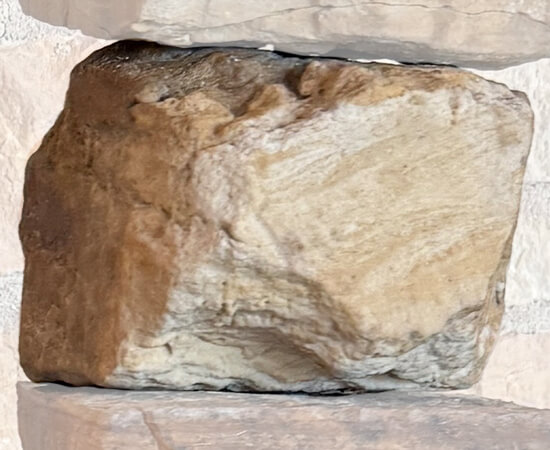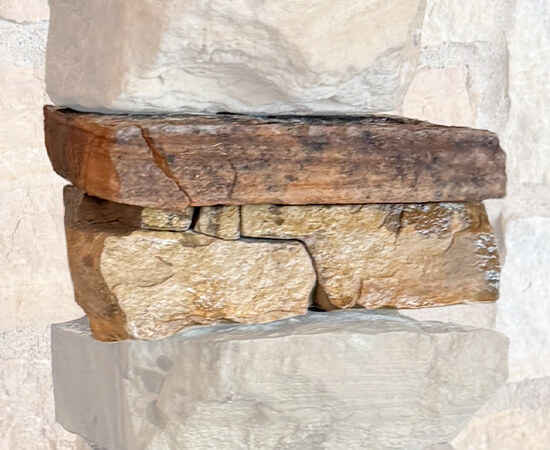STRATIGRAPHY AND LITHOLOGY OF SMSC LAND
The stratospheric column at Hoċokata Ṫi displays the geological history of the Shakopee Mdewakanton Sioux Community (SMSC) lands. The layers of rock displayed in the column were formed over the past billion years as bodies of water advance and retreated over the area (called a transgression-regression cycle), depositing a variety of material that eventually became a mosaic of rock and sandstone. The layered rock on Hoċokata Ṫi’s exterior and interior spaces represent the different formations of the earth that the building sits on.
Information below provided by the SMSC Land and Natural Resources Department.


SHAKOPEE FORMATION
Paleozoic Era
Late Ordovician Period
Deposited approximately 425 million years ago
What was happening during this time? Most of North America consisted of intermittent seas, with Minnesota located within a transition zone. As water levels increased and decreased during this period, deposition varied between beach/barrier island sand and limestone. Aquatic life was abundant and diverse, with significant numbers of corals, shelled cephalopods, and bivalves (clams, etc.).
Geologic description: Fine-to-very-fine grained dolomite interlayered with thin bands of chert, shale, and quartz arenite. A bottom layer of sandstone (often referred to as New Richmond Sandstone) lies above the Oneota Dolomite. The Shakopee Formation contains fractures and dissolution cavities throughout the dolomitic layers.

ONEOTA DOLOMITE
Paleozoic Era
Middle Ordovician Period
Deposited approximately 475 million years ago
What was happening during this time? Like the Shakopee Formation, Oneota Dolomite was deposited in offshore shallow sea environments. It has less sand than the Shakopee Formation, which may indicate that it was deposited during a time of deeper water levels.
Geologic description: A nearly pure dolomite layer, containing much less sand than the overlying Shakopee Formation. Oneota Dolomite is heavily quarried as a building material due to its high durability.

JORDAN SANDSTONE
Paleozoic Era
Late Cambrian Period
Deposited approximately 485 million years ago
What was happening during this time? Extensive epeiric seas covered large areas of the continents, where sedimentation occurred in relatively shallow, stable environments. The Jordan Sandstone was formed in a coastal-to-shallow marine setting with conditions conducive to the deposition of well-sorted, quartz-rich sandstones. The region was likely influenced by gentle marine currents and had a relatively low sediment influx, contributing to the formation of these distinctive sandstones.
Geologic description: Varies slightly by depth, but most commonly consists of quartzose and feldspathic sections with little clay content. Exposures often show hummocky cross-stratifications, which are thought to indicate marine dune environments. Hummocky cross-stratifications are the line like striations that can be seen on the face of the rock sample. The Jordan Formation is commonly bioturbated but rarely fossiliferous (though marine fossils such as trilobites can be found in some areas). The Jordan Formation has become a popular frac sand target in recent years due to its relatively high-grade sands.

ST. LAWRENCE FORMATION
Paleozoic Era
Late Cambrian Period
Deposited approximately 490 million years ago
What was happening during this time? The area was blanketed by a shallow level of warm, clear waters.
Geologic description: A formation comprised of interbedded deposits of mud and sand. The unit consists of fine-grained sandstones layered in between dolostone, siltstone, and shales with dolomitization increasing downward.

TUNNEL CITY GROUP(FRANCONIA FORMATION/IRONTON SANDSTONE/GALESVILLE SANDSTONE)
Paleozoic Era
Late Cambrian Period
Deposited approximately 495 million years ago
What was happening during this time? As with the other Late Cambrian Period deposits, the Tunnel City Formation is indicative of warm shallow seas that covered much of the region.
Geologic description:
FRANCONIA FORMATION: A well-sorted, fine-grained sandstone that’s medium to highly glauconitic and contains feldspar and mica. Structures include abundant bioturbation burrows, hummocky, trough, and tabular crossbedding. Some parts of the Tomah Member have an abundance of green micaceous shale partings.
IRONTON SANDSTONE/GALESVILLE SANDSTONE: Consists of both upper fossiliferous (Ironton) and lower non-fossiliferous (Galesville Sandstone) fine-to-coarse grained subfeldspathic arenites. Grain size increases upward from the Galesville Sandstone layer and decreases at contact with the Ironton Sandstone layer. This reversal in grading demonstrates a shift from a transgressive succession to a regressive succession.

EAU CLAIRE FORMATION
Paleozoic Era
Middle Cambrian Period
Deposited approximately 500 million years ago
What was happening during this time? This formation, primarily composed of sandstone and shale, reflects sedimentary conditions of a shallow marine environment.
Geologic description: Interbedded siltstone, mudstone, and shale with scattered beds of very fine-grained quartzose sandstone.

MT. SIMON FORMATION
Paleozoic Era
Beginning of the Late Cambrian
Deposited approx. 505 million years ago
What was happening during this time? The environment was a shallow marine or nearshore setting marked by high-energy conditions that promoted the accumulation of clean, quartz-rich sands. These sediments were likely deposited in an ancient epeiric sea, where strong waves and currents played a significant role.
Geologic description: Medium-to-coarse grained, poorly cemented quartzose sandstone that may contain granules and pebbles of quartz in lower parts of the formation, as well as thin beds of mudstone.

HINCKLEY & FOND DU LAC FORMATIONS
Precambrian Era
Late Proterozoic Period
Deposited approximately 1 billion years ago
What was happening during this time? The supercontinent Rodinia was breaking apart, creating large rifts. During this time, the Midcontinent Rift System formed—a failed rift that would have split North America in half, stretching from Lake Superior to Kansas. As this rift opened, volcanic eruptions filled it with dense, basaltic lava flows. Over time, the weight of the basalt caused the area to sag, forming a long basin. Sand carried by streams and wind accumulated in the basin, and minerals from groundwater eventually cemented the sand grains into sandstone. The Hinckley Sandstone Formation, one of several sandstone units deposited, is cemented with iron oxide and silica. The iron oxide gives it a light-brown color, while the silica makes it one of the strongest sandstones in Minnesota. Rift Valleys still occur on Earth today and can be seen in places such as the East African Rift region.
Geologic description: The Hinckley and Fond du Lac Formations are composed of interbedded mudstone, siltstone, and lithic sandstone. Fine-to-coarse grained quartzose sandstone of the Hinckley Formation sporadically overlays the interbedded shale and arkosic sandstone of the Fond du Lac Formation.

